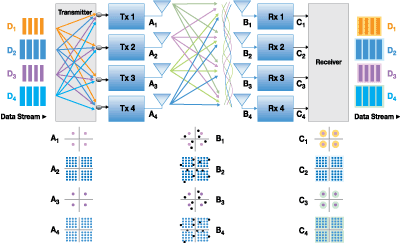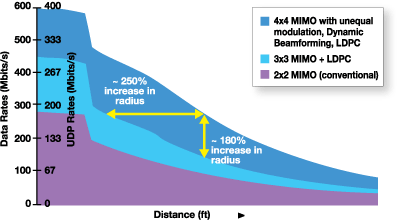Video entertainment networking requires robust wireless home-networking technology
BY BEHROOZ REZVANI
Quantenna Communications
Fremont, CA
www.quantenna.com
How good must wireless technology be to support multiple streams of HD video? That’s the critical question carriers are asking as they seek to deploy wireless entertainment solutions with enough reach and performance to support multiple streams of HD video with an optimal viewing experience.
At the same time, these solutions must achieve the lowest possible cost of deployment. As service providers adopt wireless technologies for economically deploying video-networking services, they need to take a number of issues into account.
These issues grow in complexity with the advent of ever-larger, higher-resolution flat-panel TVs. A 30-Mbit/s video-encoding rate is needed to support as many as four TVs plus game consoles. Twice this performance is needed if you include wireless gaming with low-latency response capabilities.
Even this might not be enough to support some HD compressed sources with much higher peak data rates. It’s safe to say that sustained rates of at least 120 Mbits/s will be required to deliver compressed HD video in the downstream direction from sources including STBs, RGWs, and NAS boxes and even more to support higher peak rates.
While multiple-input multiple-output (MIMO) wireless architectures offer the best solution for optimizing connection strength and reliability for consumer entertainment, there is a significant performance delta between older 2×2 and 3×3 MIMO solutions and the latest-generation 4×4 systems. This is especially true when comparing older solutions to 4×4 MIMO offerings that also include dynamic beamforming and low-density parity check (LDPC). Developers of next-generation multimedia and entertainment systems must consider a number of issues that have a direct impact on video networking performance and the quality of the ultimate consumer viewing experience.
The easiest way to quantify and evaluate the user experience is through measurements of long-term averages for Packet Error Rate (PER). Enabling consumers to continuously view high-quality, glitch-free images requires a very low PER on the order of 0.01 to 0.001%.
Low PER becomes even more important at higher bandwidth rates. The growth in TV size, contrast ratio and color resolution is driving bandwidth demand, and higher dynamic range is also required for transferring HD content.
A large-scale shift has occurred from 1080i-30 to 1080P-60 resolution, frame rates of 120/240 frames per second (fps) are increasingly common, and 3D TV adoption is also pushing the need for more bandwidth. Add to that the requirements for viewing very high-quality HD content on larger screens up to 72 in. and speeds of 30 Mbits/s or higher will soon be required to ensure a satisfactory viewing experience.
Even more bandwidth may be required for video gaming. Wireless technology will need to support low-latency (sub-10-ms) video game encoding/decoding technology by delivering as much as 60 Mbits/s for a fairly large screen.
Advantages of higher MIMO antenna order
Wireless MIMO channels are multipath systems whose reflections create multiple that can be harnessed to significantly improve wireless performance. The more independent paths that can be created (also known as channel rank), the better the signal-to-noise ratio (SNR) as each antenna contributes the results from its independent sampling.
One spatial stream is assigned per antenna, and each can carry up to 150 Mbit/s in a 40-MHz bandwidth in the 802.11n protocol as long as there is adequate SNR. To maximize available bandwidth, two spatial streams can be multiplexed over an array of 4×4 antennas with only two available independent paths. The use of extra antennas (such as two antennas per spatial stream) results in a doubling or more of signal reliability.

Fig. 1. In this example of a 4×4 MIMO system with four spatial stream multiplexing, the spatial streams, due to this spatial signature, are not equally modulated. Streams 1 and 3 are QPSK modulated (per subcarrier -OFDM) and streams 2 and 4 are 64-QAM modulated (per subcarrier -OFDM).
Importance of beamforming
Beamforming is an increasingly critical technology for enhancing the wireless connection between transmitters and receivers. It enables the MIMO system optimize SNR of the received signal. The receiver first tries to estimate the channel matrix (the channel between the transmitter and the receiver), and then tells the transmitter how to precompensate on a tone-by-tone basis.
When beamforming is done dynamically, the MIMO receiver and transmitter can work together to redirect the beam so that the system can mitigate and/or preempt the adverse effects of any objects that are blocking or deflecting the beam. The use of explicit beamforming (in which both the forward and backward channels are estimated separately) avoids problems related to power amplifier nonlinearity in the link’s downstream and upstream directions and any possible miscalibration.
Achieving full channel (or ergodic) capacity is very difficult without the help of transmit beamforming. Transmit beamforming also must be adaptive so that the system can adapt quickly and dynamically to channel changes. Without this ability, there is capacity (data rate) loss and no chance of achieving maximum channel capacity and full data rate.
Additionally, adequate beamforming update rate is essential for dealing with home dynamics that impact channel conditions. Because high compression ratios require very deep (approximately 100 ms) memory, a good beamforming update rate should be between 20 and 100 ms. Beamforming also can be adaptive in this range, depending on channel conditions.
Beamforming also should be explicit in order for the forward and backward channels to both be accurately estimated. Explicit beamforming is the most reliable and accurate method, and contrasts with implicit adaptive beamforming, which requires considerable nonlinear estimation and calibration. Implicit beamforming can cause disruption in image quality if it is not accurate, even for a short period of time.
Performance comparisons
Outage probability, or the percentage of channels that are unable to support a specific data rate, is one of the first metrics to consider when comparing the performance of available wireless systems Data rate analysis from simulated rate/reach curves doesn’t provide an accurate picture since the results are upper-bounded due to fixed channel assumptions.
Outage probability, is equal to PER with ideal code, and at the lower bound of PER with non-ideal code. Tests show that in a 3×3 MIMO system supporting two streams of 64-QAM, 31.9% of the channels would not provide “reliable” transmission for two streams of 64-QAM at the specific received SNR per chain — 20 dB in this case. In contrast, a 4×4 system has an outage probability of 1%.
Another way to compare wireless systems is on the basis of rate/reach curves for the same channel conditions. Generally, correlated MIMO channels possess fewer degrees of freedom relative to ideal, fully scattered channels. As the SNR decreases, the number of spatial streams also decreases, which reduces the multiplexing gain of the MIMO system. The analysis in Fig. 2 focuses on a channel model consisting of three 10-dB walls spaced very close to the transmitter.

Fig. 2. In this simulation graph, the 4×4 system’s throughput outperforms that of a 3×3 system by about 180% at a distance of 50 ft.
More improvements in the future
Consumers are used to wired Ethernet and expect the same connection quality with wireless technology. Clearly, 2×2 MIMO is completely unsuitable for this task, and 3×3 MIMO technology is insufficient as a long-term home-networking solution. 4×4 MIMO offers a superior alternative, and the cost of goods (COG) delta between 4×4 and 3×3 MIMO systems is expected to drop to below $1 as 4×4 systems benefit from economies of scale.
Moving forward, 4×4 MIMO technology with extended video-networking features will provide superior coverage as compared to alternative solutions. 4×4 solutions also are expected to exceed 120 to 150 Mbits/s over 95% homes, which will reduce deployment costs. The remaining large (that is, 7,000 sq. ft or more) homes will be able to use a single mesh node with frequency reuse capability. This will enable 4×4 MIMO to achieve nearly 100% coverage in all homes across the globe, while delivering a minimum of 100-Mbit/s data rates with near-zero PER data transfers. Further advances will continue to improve the reach, reliability and throughput of 4×4 MIMO systems so they can deliver even more simultaneous streams of full HD video and other multimedia and entertainment content, anywhere in the home. ■
Advertisement
Learn more about Quantenna Communications





